24 Hours of Light
Light is something we experience every day. For most people, "light" refers to what humans can detect with our eyes. It is illumination, what ignites our visual sense, the yin to the yang of dark. However, the type of light humans can detect with our eyes is just a small fraction that exists, and the true nature of light is much more expansive.
In many ways, light behaves like a wave and this is the key to understanding its amazing capabilities. How tightly packed — or far apart — the waves are dictates light's properties. For example, the longer the wave, the less energy the light typically carries, and vice versa. Each type of light has its own "super powers" both in their natural forms and in ways sculpted by science and technology.
Picture a piano keyboard. The popular definition of light would inhabit a few keys around middle C, while the rest of the piano represents the full breadth of light and its many forms. On one end of the piano of light, there are radio waves. As you move up through the octaves, there are other forms of light including microwaves, infrared, "visible" light, ultraviolet, X-rays, and gamma rays.
The presence of light in our lives, particularly in its invisible manifestations, is so commonplace that most of the time we do not even take notice. May 16, 2018 has been declared the International Day of Light by the United Nations, and it is an excellent opportunity to explore the many ways we use and need light — in all of its forms — throughout our daily lives.
Here we look at some examples of light in our lives throughout the course of one day.
12:00 am: On a clear, Moon-less night we can see thousands of stars away from the light pollution of urban areas.

1:00 am: The cosmos has much more than meets the unaided human eye, however. Most cosmic objects — including stars — emit light in many forms, spanning from radio waves to gamma rays.
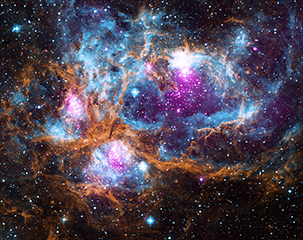
2:00 am: As we are tucked warmly in our beds asleep, our bodies are radiating heat. This heat is invisible to us, but it is detectable as infrared light by specially-designed cameras.

3:00 am: As they prepare the early morning weather forecast, meteorologists consult satellite imagery that contains data in microwave light that can penetrate clouds and reveal precipitation.

4:00 am: Making their way back their roost, bats catch food by sending out radio waves (which are converted into sound waves) and using the echoes to "see" their prey.

5:00 am: Sunlight begins to peek through your window, signaling the start of a new day. Although it emits the yellow band of visible light most strongly, our Sun gives off light in many forms.

6:00 am: A microwave oven uses specific wavelengths that excite water molecules, causing heat to build in the food they are meant to warm or cook.

7:00 am: Stepping out into a sunny day, don't forget to apply sunscreen. Some, but not all, of the ultraviolet light radiated by the Sun can cause damage to human cells, including skin.

8:00 am: On your way to an appointment, you drive over a bridge. Engineers use "industrial radiology" — that is, sending X-rays or gamma rays — to test the strength of things like welds and machined parts.

9:00 am: Running late? GPS uses a fleet of orbiting satellites to send precise, triangulated radio waves to nearly all spots on Earth, delivering valuable time and position information.

10:00 am: After a quick rainstorm, a rainbow appears in the sky. When sunlight enters a droplet of rain, its path is bent and the multiple colors (red, orange, yellow, green, blue, violet, and indigo) emerge.

11:00 am: A trip to the dentist brings X-rays. Because it is one of the most energetic forms of light, X-rays can penetrate muscle and tissue, casting shadows on detectors of denser bone and teeth.
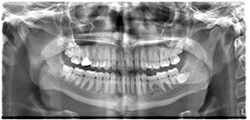
12:00 pm: Checking your email, data streams over fiber optic cables, which are made of strands of glass or plastic that carry emails, videos, photos and more in the form of infrared light.
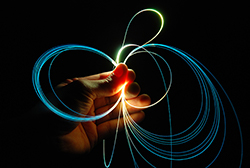
1:00 pm: With a quick stop at a store, you hand over your credit card to the clerk. On the back is a watermark that only fully reveals itself in ultraviolet light, enhancing security against theft.

2:00 pm: Once outside, you shield your eyes from the light of the Sun with your hand, creating a shadow across your eyes. Almost any type of light can be blocked to generate a shadow.

3:00 pm: Somewhere in the Universe a star explodes, sending the elements necessary for life as we know it into space. Scientists can study these stellar debris fields with telescopes like Chandra.

4:00 pm: You plug in your smart phone to a solar charger that transforms the energy from sunlight into electricity through photovoltaic cells.

5:00 pm: Traveling through an airport, you pass through a "millimeter wave scanner" which scans the passengers for concealed objects in a specific band of radio waves.
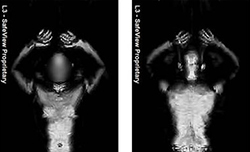
6:00 pm: As the Sun sets, you notice it looks more oblong-shaped than circular. This is due to the bending of the light from the Sun as it passes through more of Earth's atmosphere close to the horizon.

7:00 pm: A news report describes an earthquake halfway across the globe. Seismologists use radio to learn more about this geological event and hopefully prevent damage and loss of life.

8:00 pm: Fireflies light up a meadow, revealing one of the few species that can generate their own light through "bioluminescence" (most others reflect light from an external source like the Sun).
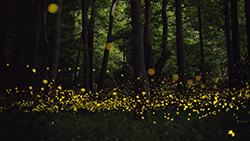
9:00 pm: The neon lights of a diner or the Las Vegas strip work through the collisions of atoms that release light at specific wavelengths or colors.

10:00 pm: As you click on the TV from your bed, the remote control communicates with the television using infrared light.

11:00 pm: Cells called rods in our eyes are responsible for vision at low levels of light, allowing our eyes to collect their final images before we drift off to sleep.
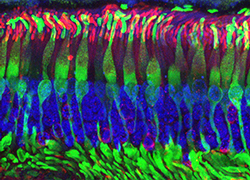
Without light, life would not be possible here on Earth. As humanity has learned more about the wonders of light, we have harnessed it in ways that would have been unimaginable just decades ago. Day or night, light and its wonders are all around us.
Kimberly Arcand and Megan Watzke are co-authors of Light: The Visible Spectrum and Beyond. This blog was originally posted for the inaugural International Day of Light on May 16, 2018 as celebrated by the United Nations and UNESCO.
Image Credits:
Star cluster NGC 6357
X-ray: NASA/CXC/PSU/L.Townsley et al; Optical: UKIRT; Infrared: NASA/JPL-Caltech
http://chandra.si.edu/photo/2016/ngc6357/
Human in infrared light
NASA/IPAC
http://coolcosmos.ipac.caltech.edu/cosmic_kids/learn_ir/index.html
Satellite data of Typhoon Saomai from 2006
Hal Pierce (SSAI/NASA GSFC)
http://earthobservatory.nasa.gov/NaturalHazards/natural_hazards_v2.php3?img_id=13772
The Townsend's big-eared bat
National Park Service
https://www.nps.gov/chis/learn/nature/townsends-bats.htm
The setting Sun over northeastern Iowa
Thomas DeHoff
http://lightexhibit.org/bio_image74.html
Microwave oven
TabataAlima cc-by-sa 4.0
https://commons.wikimedia.org/wiki/File:16microwikipedia.jpg
Our Sun in Ultraviolet light
NASA/SDO
http://lightexhibit.org/fulldisk.html
Golden Gate Bridge, San Francisco, CA.
Public domain.
Satellites
NASA
A rainbow above the mesas in Utah.
David Parker/ Science Photo Library
http://lightexhibit.org/bio_image8.html
Dental X-ray
Dmitry G
Optical fibers
Optoelectronics Research Centre, Southampton, UK
http://lightexhibit.org/fiber_optics.html
Credit card watermark
Harrihealey02 cc-by-sa 3.0
https://commons.wikimedia.org/wiki/File:Debit_card_exposed_to_ultraviolet_light-_2013-09-28_20-21.jpg
Person walking on beach
Pixabay
https://pixabay.com/en/beach-person-walking-silhouette-933297/
Solar panels
Dennis Schroeder/NREL
http://lightexhibit.org/bio_image77.html
Human in airport scanner
Transportation Security Administration
https://commons.wikimedia.org/wiki/File:Mmw_large.jpg
Sunset
Thomas DeHoff
http://lightexhibit.org/bio_image14.html
Earthquake at Iran/Iraq border
NASA/JPL
https://www.jpl.nasa.gov/spaceimages/details.php?id=PIA22112
Fireflies in a forest
Tsuneaki Hiramatu
http://lightexhibit.org/bio_image3.html
Neon lights
Wikimedia Commons — @Violetbonmua
http://hte.si.edu/own.html
TV remote control
Public domain
https://www.publicdomainpictures.net/en/view-image.php?image=17907
Human retina with rods (red), cones (green), nuclei (blue)
James Sanzo, American Cardiovascular Research Institute, Norcross, GA.
http://lightexhibit.org/bio_image58.html
Sunflowers
USDA
http://lightexhibit.org/bio_image20.html
Please note this is a moderated blog. No pornography, spam, profanity or discriminatory remarks are allowed. No personal attacks are allowed. Users should stay on topic to keep it relevant for the readers.
Read the privacy statement

